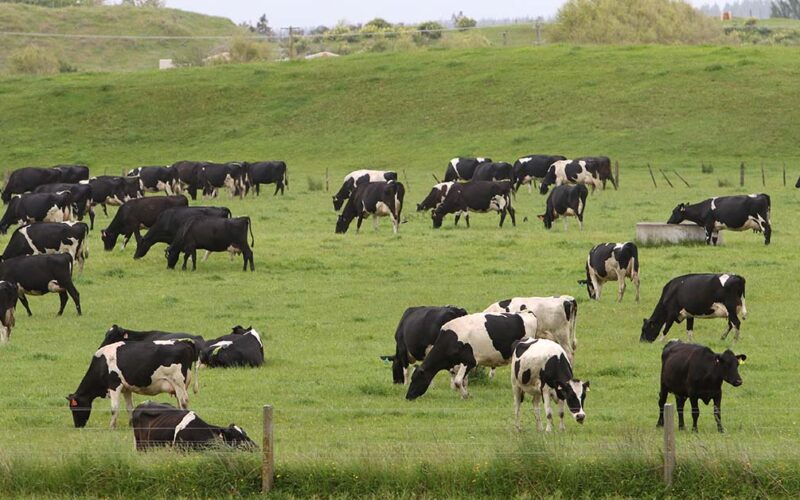Fonterra is aiming for a 30% reduction in its on-farm emissions intensity by 2030. It revealed the long-awaited target at its annual meeting in Methven on Thursday.
Eighty-six percent of Fonterra’s emissions come from on farm.
By focusing on emissions intensity, the co-op hopes to reduce the emissions produced from each tonne of FPCM (fat and protein corrected milk) collected by Fonterra by 30% compared with its 2018 baseline. The target comes after 10 months of consultation with the co-op’s 9000 farmer shareholders.
Fonterra chair Peter McBride said that the co-op’s overall on-farm emissions target will affect each farm differently.
“There is significant variation within and across farming systems when it comes to emissions intensity. We are confident that we can make solid progress towards our target by working together and sharing information, farmer to farmer.
“There’s no one solution to reducing on-farm emissions. It will require a combination of sharing best farming practices and technology to reduce emissions – it’s both our biggest opportunity and our biggest challenge.
“We have deep empathy for the challenges our farmers are already dealing with. The co-op’s approach will be to work alongside farmers, not against them, as we collectively make progress towards our target, including investing in methane-reduction technologies.”
In an online media briefing before the co-op’s annual meeting, Fonterra director of sustainability Charlotte Rutherford said the 30% target is a collective target over the whole co-operative.
“This is not a 30% intensity reduction for individual farmers but rather the cumulative result of progress in different areas for the co-op overall.”
The actions of individual farmers across the co-op will scale up to achieve that target, she said.
The co-operative has broken down the target, saying it will be achieved through a 7% reduction through farming best practice such as feed quality and improving herd performance.
A further 7% will be reduced via new technologies. Eight percent is to be reduced through carbon removals from existing and new vegetation and 8% will be reduced from historical land-use change conversions to dairy.
Rather than caps or limits on feed or cow numbers, in the short-term Fonterra will support farmers in the shift to more sustainable practices and work with industry partners as they develop tools farmers can use.
Financial incentives for paying farmers more for low-carbon milk such as through a premium or through its co-operative difference programme are not totally off the table and if they do occur, will start at a governance level, Rutherford said.
Some of the 7% reduction has already been achieved by farmers since 2018 through productivity gains and there have been no discussions of penalising farmers who are not reducing their emissions.
“This is very much about support and over time – if and when the time is right – and involving our directors and governance, we will start thinking where and when we could incentivise farmers if we feel we need to accelerate or help them more.”
Rutherford said farmers’ response so far was “eagerness to hear the ‘what’ and the ‘how’. What does it mean and how will I implement it – what does it mean for me and my farm.”
When questioned about the potential for criticism for choosing an intensity target rather than an absolute emissions target, Fonterra co-operative’s general manager of global climate policy Andrew Kempson said the co-operative is already reporting on its absolute emissions in its annual suite of sustainability reporting and will continue to do so.
“That already shows that we have reduced our absolute emissions across all gases across all scopes by 1.85 million tonnes of CO2 annually since the 2018 baseline.”
Fonterra also launched its Climate Roadmap. The roadmap is a plan that outlines the actions the co-op will take towards its 2030 targets and ambition to be net zero by 2050.
Earlier this year Fonterra lifted its emissions targets for its manufacturing and operations, this new target completes the package.
Fonterra CEO Miles Hurrell said having a full suite of targets and a plan to achieve them will provide high-value customers with the confidence to continue buying dairy from Fonterra, as well as protect its reputation as one of the most emissions efficient suppliers of dairy at scale.
In addition to this the co-op has voluntarily released its first Climate-Related Disclosure report. This report identifies risks and opportunities related to climate and helps the co-op plan for the future.
Hurrell said the announcement is important to more than just Fonterra.
The targets “will also help the country achieve its 2030 targets set under the Zero Carbon Act. We know we play a significant part in New Zealand’s emissions profile, and it’s up to all of us to work towards helping New Zealand achieve its climate targets.”
In Focus: Fonterra farmers the focus of emissions plan
Fonterra has revealed its plan to reduce on-farm emissions by 30% by 2030. Bryan unpacks the plan with Federated Farmers dairy chair Richard McIntyre (skip to the 20:10 minute mark).
In this week’s feature interview, MyFarm boss Andrew Watters talks about what he calls the third wave of land-use change and the options available to farmers looking to diversify their income (skip to the 8:50 minute mark).
And Richard Rennie reflects on his day on farm with a Bay of Plenty catchment group and talks about how Sir John might be the key Zespri is looking for as it deals with unlicensed SunGold fruit being grown in China (skip to the 1:20 minute mark).










